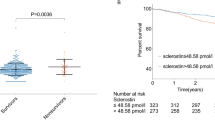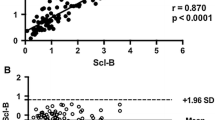Abstract
Purpose
To investigate the correlation between elevated serum sclerostin levels and chronic kidney disease outcomes for patients receiving peritoneal dialysis (PD).
Methods
We performed a prospective observational study in stable PD patients. Serum sclerostin levels were determined via enzyme immunoassay, and median levels of sclerostin were used to divide patients into high and low sclerostin groups. New-onset cardiovascular events (CVEs) and cardiovascular mortality were evaluated during a 6-year follow-up period.
Results
Ninety-eight patients [mean age 52.5 ± 10.9 years, 49% males, 21.4% diabetic, median dialysis vintage 40.7 (range 17.9–72.2) months] were recruited. Compared with those in the low sclerostin group, patients in the high sclerostin group demonstrated higher levels of total-cholesterol, NT-proBNP, and osteoprotegerin (all P < 0.05). During the 6-year study period, 25 CVEs and 17 cardiovascular deaths occurred in the high sclerostin group, whereas 11 CVEs and four cardiovascular deaths occurred in the low sclerostin group. A Cox regression analysis determined that high sclerostin levels significantly increased the risk for CVEs (HR 2.475, 95% CI 1.116–5.489, P = 0.026) and cardiovascular death (HR 3.484, 95% CI1.134–10.706, P = 0.029), after multiple adjustments were made.
Conclusions
Our data suggest that high sclerostin levels may predict the onset of CVEs and cardiovascular mortality among PD patients.

Similar content being viewed by others
References
Collins AJ et al (2009) United States renal data system 2008 annual data report. Am J Kidney Dis 53(1 Suppl):S1–S374
Nitta K (2011) Vascular calcification in patients with chronic kidney disease. Ther Apher Dial 15(6):513–521
Raggi P, Kleerekoper M (2008) Contribution of bone and mineral abnormalities to cardiovascular disease in patients with chronic kidney disease. Clin J Am Soc Nephrol 3(3):836–843
Baron R, Rawadi G (2007) Wnt signaling and the regulation of bone mass. Curr Osteoporos Rep 5(2):73–80
Li X et al (2008) Targeted deletion of the sclerostin gene in mice results in increased bone formation and bone strength. J Bone Miner Res 23(6):860–869
Fang Y et al (2014) Early chronic kidney disease-mineral bone disorder stimulates vascular calcification. Kidney Int 85(1):142–150
Kramann R et al (2013) Novel insights into osteogenesis and matrix remodelling associated with calcific uraemic arteriolopathy. Nephrol Dial Transplant 28(4):856–868
Claes KJ et al (2013) Sclerostin: another vascular calcification inhibitor? J Clin Endocrinol Metab 98(8):3221–3228
de Oliveira RB et al (2013) Disturbances of Wnt/beta-catenin pathway and energy metabolism in early CKD: effect of phosphate binders. Nephrol Dial Transplant 28(10):2510–2517
Cejka D et al (2014) Renal elimination of sclerostin increases with declining kidney function. J Clin Endocrinol Metab 99(1):248–255
Kanbay M et al (2016) Sclerostin, cardiovascular disease and mortality: a systematic review and meta-analysis. Int Urol Nephrol 48(12):2029–2042
Kanbay M et al (2014) Serum sclerostin and adverse outcomes in nondialyzed chronic kidney disease patients. J Clin Endocrinol Metab 99(10):E1854–E1861
Goncalves FL et al (2014) Serum sclerostin is an independent predictor of mortality in hemodialysis patients. BMC Nephrol 15:190
Desjardins L et al (2014) Uremic toxicity and sclerostin in chronic kidney disease patients. Nephrol Ther 10(6):463–470
Yang CY et al (2015) Circulating Wnt/beta-catenin signalling inhibitors and uraemic vascular calcifications. Nephrol Dial Transplant 30(8):1356–1363
Jean G et al (2016) High serum sclerostin levels are associated with a better outcome in haemodialysis patients. Nephron 132(3):181–190
Payne RB et al (1973) Interpretation of serum calcium in patients with abnormal serum proteins. Br Med J 4(5893):643–646
Orrell DH (1971) Albumin as an aid to the interpretation of serum calcium. Clin Chim Acta 35(2):483–489
Berry EM et al (1973) Variation in plasma calcium with induced changes in plasma specific gravity, total protein, and albumin. Br Med J 4(5893):640–643
Xu Q et al (2015) Association of pulmonary hypertension with mortality in incident peritoneal dialysis patients. Perit Dial Int 35(5):537–544
Gooi JH et al (2010) Calcitonin impairs the anabolic effect of PTH in young rats and stimulates expression of sclerostin by osteocytes. Bone 46(6):1486–1497
Ferreira JC et al (2013) Effects of dietary phosphate on adynamic bone disease in rats with chronic kidney disease–role of sclerostin? PLoS ONE 8(11):e79721
Drake MT et al (2010) Effects of parathyroid hormone treatment on circulating sclerostin levels in postmenopausal women. J Clin Endocrinol Metab 95(11):5056–5062
Bellido T et al (2005) Chronic elevation of parathyroid hormone in mice reduces expression of sclerostin by osteocytes: a novel mechanism for hormonal control of osteoblastogenesis. Endocrinology 146(11):4577–4583
Pelletier S et al (2013) The relation between renal function and serum sclerostin in adult patients with CKD. Clin J Am Soc Nephrol 8(5):819–823
Thambiah S et al (2012) Circulating sclerostin and Dickkopf-1 (DKK1) in predialysis chronic kidney disease (CKD): relationship with bone density and arterial stiffness. Calcif Tissue Int 90(6):473–480
Morena M et al (2015) Osteoprotegerin and sclerostin in chronic kidney disease prior to dialysis: potential partners in vascular calcifications. Nephrol Dial Transplant 30(8):1345–1356
Koo HM et al (2011) Elevated osteoprotegerin is associated with inflammation, malnutrition and new onset cardiovascular events in peritoneal dialysis patients. Atherosclerosis 219(2):925–930
Nakashima A et al (2011) Plasma osteoprotegerin, arterial stiffness, and mortality in normoalbuminemic Japanese hemodialysis patients. Osteoporos Int 22(6):1695–1701
Kuzniewski M et al (2016) Osteoprotegerin and osteoprotegerin/TRAIL ratio are associated with cardiovascular dysfunction and mortality among patients with renal failure. Adv Med Sci 61(2):269–275
Magoori K et al (2003) Severe hypercholesterolemia, impaired fat tolerance, and advanced atherosclerosis in mice lacking both low density lipoprotein receptor-related protein 5 and apolipoprotein E. J Biol Chem 278(13):11331–11336
Fujino T et al (2003) Low-density lipoprotein receptor-related protein 5 (LRP5) is essential for normal cholesterol metabolism and glucose-induced insulin secretion. Proc Natl Acad Sci USA 100(1):229–234
Behari J et al (2010) Liver-specific beta-catenin knockout mice exhibit defective bile acid and cholesterol homeostasis and increased susceptibility to diet-induced steatohepatitis. Am J Pathol 176(2):744–753
Urano T et al (2012) Association of circulating sclerostin levels with fat mass and metabolic disease–related markers in Japanese postmenopausal women. J Clin Endocrinol Metab 97(8):E1473–E1477
Yamada S et al (2015) Factors associated with serum soluble inhibitors of Wnt-beta-catenin signaling (sclerostin and dickkopf-1) in patients undergoing peritoneal dialysis. Nephrology (Carlton) 20(9):639–645
Sabbagh Y et al (2012) Repression of osteocyte Wnt/beta-catenin signaling is an early event in the progression of renal osteodystrophy. J Bone Miner Res 27(8):1757–1772
Drechsler C et al (2015) High levels of circulating sclerostin are associated with better cardiovascular survival in incident dialysis patients: results from the NECOSAD study. Nephrol Dial Transplant 30(2):288–293
Poole KE et al (2005) Sclerostin is a delayed secreted product of osteocytes that inhibits bone formation. FASEB J 19(13):1842–1844
Zhu D et al (2011) The appearance and modulation of osteocyte marker expression during calcification of vascular smooth muscle cells. PLoS One 6(5):e19595
Brandenburg VM et al (2013) Relationship between sclerostin and cardiovascular calcification in hemodialysis patients: a cross-sectional study. BMC Nephrol 14:219
Koos R et al (2013) Sclerostin as a potential novel biomarker for aortic valve calcification: an in vivo and ex vivo study. J Heart Valve Dis 22(3):317–325
Hampson G et al (2013) The relationship between inhibitors of the Wnt signalling pathway (Dickkopf-1(DKK1) and sclerostin), bone mineral density, vascular calcification and arterial stiffness in post-menopausal women. Bone 56(1):42–47
Funding
This study was supported through grants from the National Nature Science Foundation of China (81670691, 81370864), and the Shanghai Municipal Education Commission-Gaofeng Clinical Medicine Grant (20152211).
Author information
Authors and Affiliations
Corresponding author
Ethics declarations
Conflict of interest
The authors declare that they have no conflict of interest.
Ethical approval
This study received ethics approval from the ethics committee of Renji Hospital, School of Medicine, Shanghai Jiao Tong University. It was performed in accordance with the ethical standards of the institutional and/or national research committees as well as with the 1964 Declaration of Helsinki and its later amendments.
Informed consent
Informed consent was procured from all individual patients who participated in the study.
Rights and permissions
About this article
Cite this article
Gong, L., Zheng, D., Yuan, J. et al. Elevated levels of serum sclerostin are linked to adverse cardiovascular outcomes in peritoneal dialysis patients. Int Urol Nephrol 50, 955–961 (2018). https://doi.org/10.1007/s11255-018-1795-z
Received:
Accepted:
Published:
Issue Date:
DOI: https://doi.org/10.1007/s11255-018-1795-z




